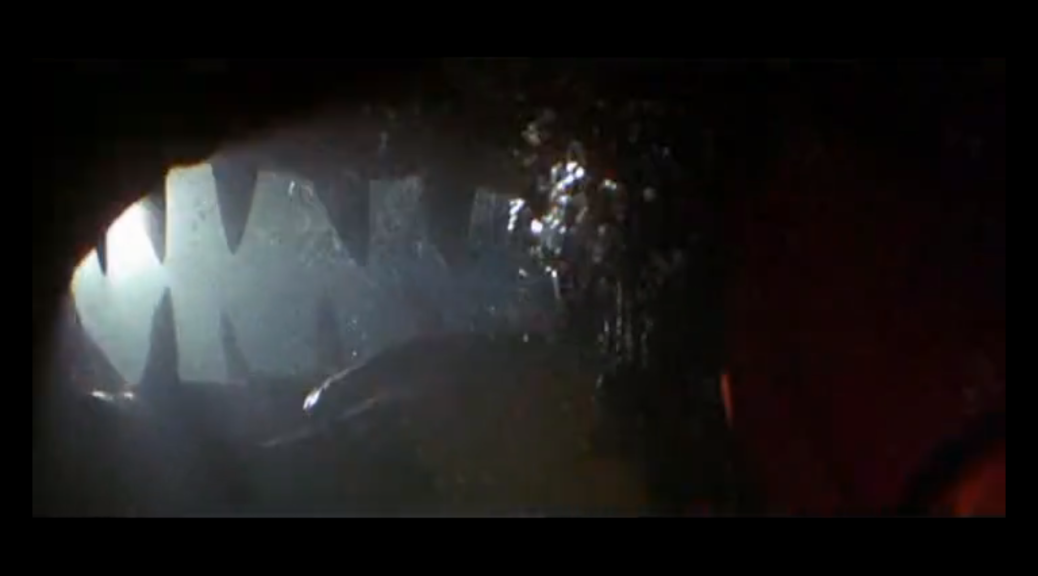JAWS TURNS 40: A COMMENTARY AND REVIEW OF JAWS 3-D
JAWS 3-D

Pros: The 3-D is actually pretty cool no matter what anyone says; enjoyable enough as a time-waster
Cons: Many aspects of the film are problematic…
June 20, 2015 marked the fortieth anniversary of the release of Steven Spielberg’s original Jaws, a film that provided Hollywood with the blueprint by which most every future blockbuster would be made and remains one of the most suspense-filled pictures ever. In honor of this event, the film was re-released for a limited number of theatrical showings with an introduction provided by Turner Classic Movies host Ben Mankiewicz. Seeing this film in theaters, as I did this past weekend, makes one appreciate just what an magnificent achievement it was in 1975: though it features a rarely seen – and obviously rubber – “monster,” the tension level of the piece increases steadily, especially during its second half in which the three main characters actively hunt down a gigantic man-eating shark (it was clear during the screening I attended that several audience members were experiencing the film for the first time – one young moviegoer commented afterward that it was “unbearable” in terms of its tension level – quite a feat for a flick now entering its fourth decade of existence). This theatrical screening also demonstrated just how innovative and astounding the sound design and editing was: Jaws (deservedly) won the Oscar in this category, though it’s difficult to appreciate this aspect of the film when viewing it at home.
 Let’s face it: any and all Jaws sequels suffered from a lack of Robert Shaw’s Quint character.
Let’s face it: any and all Jaws sequels suffered from a lack of Robert Shaw’s Quint character.
Though I can’t remember the first time that I saw many of the thousands of films that I’ve watched in my lifetime, I clearly remember the first time I saw Jaws: in the upstairs of my grandparent’s house, alone one Sunday night. Having been mesmerized by what I was seeing, I instantly fell in love not only with this film, but movies in general – and horror movies in particular. I have many fond childhood memories of watching the various Jaws sequels – the capably-made second film and the hideously awful fourth one Jaws: The Revenge among them. It may be the third film in the series, 1983’s Jaws 3-D, that’s the oddest one of the bunch: usually referred to simply as Jaws 3, this film featured many visuals that, when viewed in standard 2-D format, looked strangely “flat” and out-of-place.
Moments like this look terrible in 2-D prints of the film…
While the film has never been officially released in the United States in its original 3-D format (which is puzzling considering the recent resurgence of the format), I had the opportunity to view this version of the film, which required the familiar red and cyan glasses. Jaws 3-D has frequently been referred to as having little connection to the other films in the series and that’s an honest enough statement. Admittedly, the film was written without any connection to the previous films, with the Mike and Sean Brody characters tossed in randomly and arbitrarily at the last minute per the request of the studio. Additionally, while the previous two Jaws films (and part of Jaws: The Revenge) took place on the vacation community of Amity Island, Jaws 3-D takes place at an ocean-side Sea World park that’s preparing for its grand opening. Funded by an oily businessman named Calvin Bouchard (enter a slick and sleazy Louis Gossett, Jr.), the park’s main attraction is a labyrinthine network of underwater tunnels that traverse an on-site lagoon and allow patrons a glimpse at various species of fish and marine life dwelling there. On some level, the film is more about the park and its personnel dealing with unfortunate events than about a killer shark on the rampage, and I think some of the problems people have with the film is that it never quite settles into any familiar story formula.
…inspiring this sort of reaction.
Head of the mechanical department at the Sea World park is Mike Brody (played by a young Dennis Quaid), son of Amity police chief Martin, who is romantically involved with the park’s head dolphin trainer Kathy (perky Bess Armstrong), and as the film begins, these two are preparing for a visit from Mike’s younger brother Sean (again, a character featured in the earlier Jaws films who’s played here by John Putch). Mike, Kathy, Sean, and Calvin are in for a surprise however, since it quickly becomes clear that an unexpected guest has arrived at the park in the form of a juvenile great white shark. While Calvin wants to exterminate the creature, Kathy recognizes its value as a potential draw for park visitors – no marine park in the world has a live great white on display. Where there’s a young shark however, it’s mother can’t be far behind, and when this – are you ready for it? – thirty-five foot mean mama arrives on the scene, the fate of the park and everyone in it comes into jeopardy.
Entrance to the “Undersea Kingdom” at the fictional Sea World park featured in the film. The film’s 3-D looks especially good when relating the distance between objects in the frame’s background and foreground.
Jaws 3-D was the product of several writers (famed author Richard Matheson and Jaws series veteran Carl Gottlieb are credited with the screenplay, working from an original treatment by Guerdon Trueblood, known to me as the director of the enjoyably trashy 1973 exploitation flick The Candy Snatchers) – and it shows: the basic story here is kind of a mess, walking the tightrope between seeming like a ‘70s disaster movie and a more recognizable horror film, getting especially clunky as it nears its conclusion. One can notice a few glimpses of Matheson attempting to create some interesting moments in an otherwise lame picture (one scene in which a Sea World spokesman attempts to “cover his ass” in a television interview when it’s very apparent that human lives are in danger in the park is a not-so-subtle jab at modern politicians), but the writer was reportedly furious over various rewrites and “doctoring” that changed the whole complexion of his work.
 How is it possible that the quality of the shark model actually decreased as the series went along despite numerous special effect innovations?
How is it possible that the quality of the shark model actually decreased as the series went along despite numerous special effect innovations?
First-and-only-time director Joe Alves Jr., production designer on Spielberg’s original Jaws, was at the helm here and clearly was in over his head. Producers of the picture believed that the 3-D gimmick could hide some of Alves’s directorial miscues, and it probably does to some degree. Still, Jaws 3-D exists in a world of murk, and not just because of its clumsy script: three cinematographers are credited (Chris Condon, James A. Contner, and Austin McKinney), but by and large the picture is muddy and dark. A viewer can’t see what’s going on during many of the key moments, a notion that’s only accentuated by Alves’s poor handling of various moments of excitement: it’s actually at its worse whenever the “feeding machines” do show up.

Jaws 3-D shark attacks — with actual murk!!
Special effects were accomplished using a variety of techniques, but the mother shark is largely related to the screen by use of an obviously mechanized mock-up that’s capable of precisely three actions – swishing its head left, right, and articulating its jaw line. The creature never seems capable of actually “attacking” anyone – it’s way too lumbering and sluggish to even catch up to most potential prey items, making any of the poorly-visualized attack sequences more perplexing and goofy than scary (a viewer has to use a lot of imagination to make sense of what’s being seen). This is especially true during a sequence when cocky underwater photographer Philip FitzRoyce (played in the manner of a chauvinistic hotshot by British actor Simon MacCorkindale) attempts to lure the beast into a drain pipe where it can be contained and exterminated. Viewers see FitzRoyce swimming in front of the shark one minute and inside the creature’s gullet the next, as if he’d been virtually inhaled by the fish. Simply put: the mama shark is never effectively sold as a threatening or even especially intimidating menace even though it does manage to all but shut the park down by destroying the underwater infrastructure.
Admittedly, Jaws 3-D is no masterpiece – even when compared to the generally mediocre second film in the series, but it does have a few positive elements working in it. Viewed in its original 3-D version, visuals have a nice sense of “depth” to them, with objects in the foreground appearing closer to the viewer than ones in the back. The actual 3-D effect images (which include a floating fish head, severed arm, and the final sequence in which a shark approaches and smashes through the large window of an underwater control room) are pretty nifty despite the sketchy quality of the photography: these moments definitely look better in the film’s original version than they do on 2-D TV and video prints, which points more to flaws in the film’s transfer to 2-D than to anything inherently wrong with the actual production. Goofy though they are, I rather like the POV shots of one character being swallowed by the shark: clearly, being eaten alive is one of the most basic of human fears (it’s why the Jaws franchise was so successful in the first place), and Jaws 3-D is one of the few movies that attempts to capture what a victim would actually see if that happened. Finally, Alan Parker’s music score for this film is quite excellent, precisely capturing whatever mood was required. Aside from a majestic main title, Parker’s score is able to reflect the excitement of the park’s grand opening and even manages to create some semblance of tension during otherwise forgettable attack scenes.
3-D Magic!
Overly melodramatic and relentlessly talky for long stretches of time, featuring a bare minimum of shark action and an amazingly corny final shot (I chuckle every time I see it), Jaws 3-D nevertheless is agreeable enough as a pure popcorn flick, leaps and bounds more tolerable than the completely abysmal Jaws: The Revenge. Sure, some viewers will gasp and sneer at the noticeable lack of logic and pure stupidity of the film – and rightly so – but Jaws 3’s cast does a fair job of selling the sub-par script (look for a young and plucky Lea Thompson in a smaller role) and the 3-D is actually pretty cool to watch. One could point out that director Alves clearly had no business being handed the reins of this franchise, but his picture did make a significant amount of money, so it can’t be called a complete failure. For me, this is a definite “guilty pleasure” flick: one that clearly isn’t a good movie but is enjoyable in its own way. I can’t in good faith recommend Jaws 3-D, but those who like goofy genre films will probably be amused and/or entertained.
An anaglyph 3-D version of this film is only available as a – ahem – bootleg, most of which were sourced from a now-ancient VCD release. Universal’s official DVD release is the standard 2-D version, with only the theatrical trailer as an extra – a lousy package anyway one looks at it.
5/10 : A few gross dead bodies and some onscreen carnage, but not nearly as visceral as other films in the series.
4/10 : Intermittent profanity.
2/10 : Some scantily-clothed women and mild sexual innuendo and situations. No nudity.
6/10 : Will appeal to shark movie aficionados as well as those who just like bad cinema.
“Daddy…Daddy…Look at the fish!!!”
















